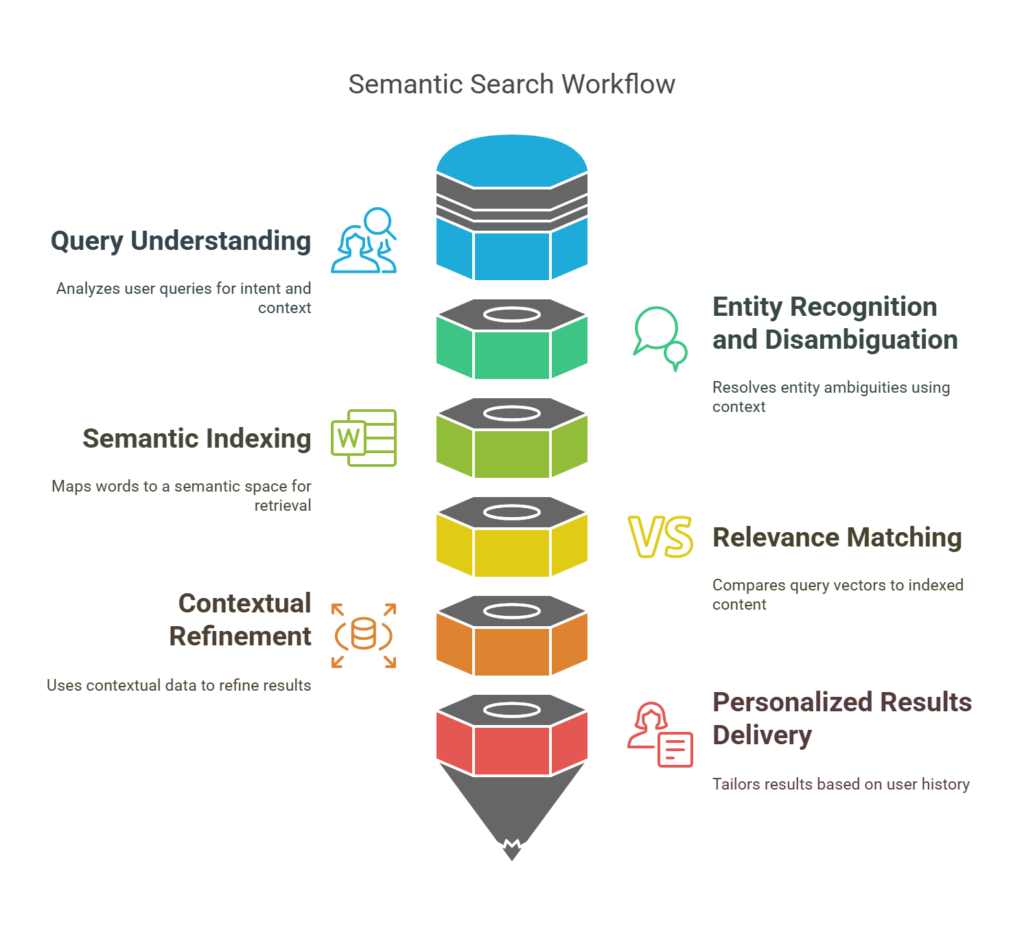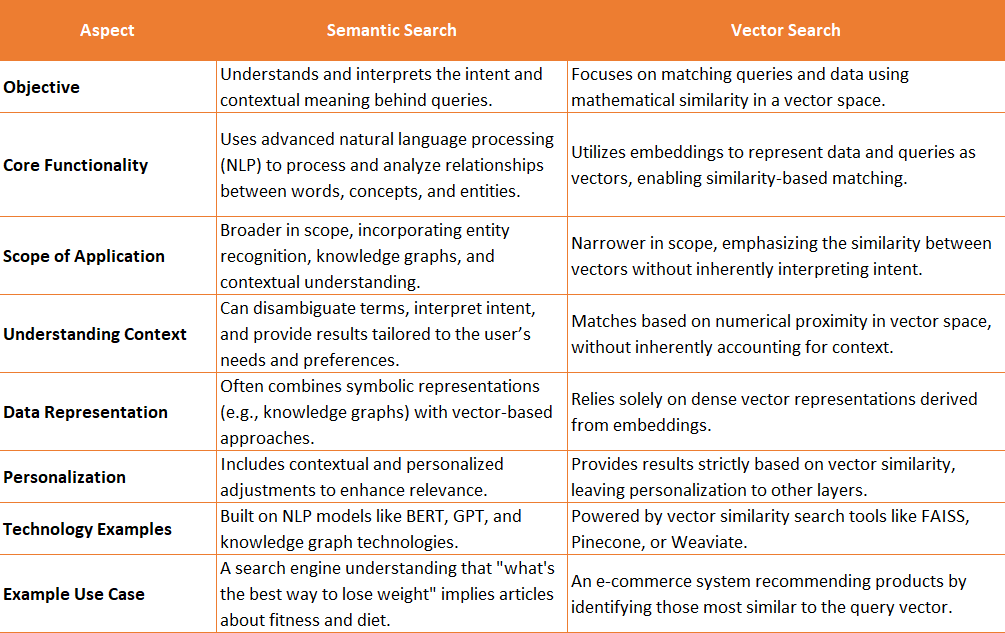시맨틱 검색이란 무엇인가요?
시맨틱 검색은 단순히 키워드를 일치시키는 것이 아니라 쿼리의 의도와 문맥적 의미를 이해하는 데 중점을 두는 고급 기술입니다. 자연어 처리(NLP), 머신 러닝, 지식 그래프를 사용하여 단어와 개념 간의 관계를 해석함으로써 쿼리에 다양한 구문이나 동의어가 사용되더라도 정확하고 의미 있는 결과를 제공합니다. 이 접근 방식은 인간의 사고 패턴과 검색 기술을 연결하여 개인화된 문맥 인식 인사이트를 제공함으로써 사용자 경험을 개선합니다. 검색 엔진, 추천 시스템, 엔터프라이즈 플랫폼에서 널리 사용되는 시맨틱 검색은 키워드 매칭을 넘어 관련성 높은 맞춤형 결과를 제공합니다.
이 가이드에서는 AI에서 시맨틱 검색의 주요 개념, 기능, 이점 및 다음과의 차이점을 다루며 그 중요성에 대해 살펴봅니다. 벡터 검색. 또한 시맨틱 검색의 실제 적용 사례를 강조하고 구현 지침을 제공합니다.
AI에서 시맨틱 검색의 역할
시맨틱 검색은 AI가 인간의 이해와 매우 유사한 방식으로 언어를 해석할 수 있게 함으로써 인간과 기계 사이의 간극을 좁혀줍니다. AI 시스템은 의도, 문맥, 개체 간의 관계를 인식함으로써 복잡한 쿼리를 처리하고 직관적이고 정확한 결과를 제공할 수 있습니다. 이러한 능력 덕분에 AI 기반 시스템은 질문에 답하고, 검색을 수행하고, 대화를 촉진하는 등의 작업을 보다 효과적으로 수행할 수 있습니다.
시맨틱 검색으로 강화된 AI 시스템은 딱딱하고 미리 정의된 규칙에 의존하지 않고 문맥에 따라 결정을 내릴 수 있습니다. 예를 들어, 시맨틱 검색을 사용하는 가상 비서는 문맥 단서를 사용하여 "Apple에서 내 러닝 재생 목록 재생"(노래 스트리밍 요청)과 "사과의 효능은 무엇인가요"(건강 관련 질문)를 구분할 수 있습니다. 이러한 문맥 이해는 다음과 같은 정확성과 유연성을 향상시킵니다. 실제 시나리오에서의 AI 애플리케이션.
시맨틱 검색에서 알아야 할 핵심 용어
다음은 시맨틱 검색의 작동 방식과 실제 적용 사례를 이해하는 데 도움이 되는 몇 가지 주요 용어입니다:
-
- 자연어 처리(NLP): 기계가 인간의 언어를 이해하고, 해석하고, 반응할 수 있도록 하는 데 초점을 맞춘 인공 지능의 하위 분야입니다. NLP는 시맨틱 검색의 중추로, 시스템이 텍스트의 구문, 의미, 정서를 분석하는 데 도움을 줍니다.
- 엔티티 인식: 쿼리 또는 문서 내에서 특정 엔터티(예: 사람, 장소, 조직)를 식별하는 기능입니다. 예를 들어, 문맥에 따라 'Apple'을 과일이 아닌 회사로 인식하는 것입니다.
- 지식 그래프: 엔티티와 개념 간의 관계를 나타내는 구조화된 데이터베이스입니다. 지식 그래프는 이해와 관련성을 향상시키는 컨텍스트와 연결을 제공하여 의미론적 검색을 돕습니다.
- 쿼리 의도: 사용자 검색 쿼리의 근본적인 목적 또는 목표. 시맨틱 검색은 사용자가 정보를 찾고 있는지, 제품을 찾고 있는지, 서비스를 찾고 있는지, 아니면 다른 것을 찾고 있는지 판단하는 것을 목표로 합니다.
- 문맥 관련성: 검색 시스템이 이전 검색, 위치, 사용자 선호도 등 검색어와 관련된 맥락을 이해하여 보다 정확한 결과를 제공하는 기능입니다.
- 단어 임베딩: 단어의 벡터 표현 사용법과 문맥에 따라 의미론적 의미를 포착합니다. 다음과 같은 인기 모델 Word2vec 그리고 GloVe 시맨틱 검색 시스템이 단어의 연관성을 이해할 수 있도록 합니다.
시맨틱 검색은 어떻게 작동하나요?
시맨틱 검색은 자연어 처리, 머신 러닝, 지식 그래프와 같은 고급 기술을 활용하여 쿼리의 의도와 문맥적 의미를 이해합니다.
다음은 시맨틱 검색이 어떻게 작동하는지에 대한 단계별 분석입니다:
쿼리 이해
시맨틱 검색은 사용자의 쿼리를 분석하여 의도와 맥락을 파악하는 것으로 시작됩니다. 시스템은 NLP 기술을 사용해 쿼리의 구문(문장 구조)과 의미(의미)를 처리합니다. 또한 주요 개체(예: 사람, 장소, 제품)와 이들의 관계를 식별합니다. 예를 들어 "초보자를 위한 AI 관련 베스트 서적"이라는 쿼리에서 시스템은 사용자가 AI나 책에 대한 일반적인 정보보다는 입문용 AI 서적을 추천하고자 한다는 것을 이해합니다.
엔티티 인식 및 모호성 제거
검색 시스템은 엔티티의 모호함을 식별하고 해결합니다. 예를 들어, 검색어가 '사과 혜택'인 경우, 시스템은 문맥을 사용하여 사용자가 과일을 가리키는지 아니면 기술 회사를 가리키는지 판단합니다. 이 작업은 엔티티 인식과 문맥 분석을 사용하여 수행되며, 종종 지식 그래프에서 지원됩니다.
시맨틱 인덱싱
시스템 데이터베이스 내의 콘텐츠는 다음과 같은 고급 기술을 사용하여 색인됩니다. 잠재 의미 분석(LSA) 또는 단어 임베딩. 이 방법은 단어와 구문을 유사한 개념이 서로 가깝게 배치된 다차원 공간에 매핑합니다. 이를 통해 쿼리가 다른 용어나 동의어를 사용하더라도 시스템에서 관련 결과를 검색할 수 있습니다.
연관성 매칭
쿼리는 벡터(의미를 수학적으로 표현한 것)로 변환되어 데이터베이스에 색인된 콘텐츠의 벡터와 비교됩니다. 이 벡터 검색은 다음을 기준으로 결과의 순위를 결정합니다. 의미적 유사성 키워드가 정확히 일치하지 않을 수 있습니다. 예를 들어, '달리기 시작하는 방법'을 검색하면 의미적 연관성 때문에 '조깅 루틴 시작'에 관한 글이 표시될 수 있습니다.
상황별 세분화
시맨틱 검색은 사용자의 위치, 검색 기록 또는 선호도와 같은 문맥 데이터를 통합하여 결과를 더욱 세분화합니다. 예를 들어, 사용자가 '자바 프로그래밍 튜토리얼'을 자주 검색하는 경우, '자바 기초'를 검색하면 자바 섬에 대한 정보보다 프로그래밍 언어에 대한 결과가 우선적으로 표시됩니다.
개인화된 결과 제공
마지막으로 시맨틱 검색은 개별 사용자에 맞게 결과를 맞춤화합니다. 과거의 상호작용을 통해 학습하여 사용자의 관심사나 업계에 맞는 콘텐츠의 우선순위를 정합니다. 이러한 개인화된 접근 방식은 시스템이 특정 요구 사항을 충족하도록 진화하도록 보장합니다.
시맨틱 검색과 벡터 검색
시맨틱 검색은 벡터 검색을 구성 요소로 사용하지만, 그 범위를 훨씬 더 확장하여 보다 심층적인 문맥 및 언어 기능을 포함합니다. 서로 밀접하게 연관되어 있지만 각기 다른 역할을 수행하며 목표를 달성하기 위해 서로 다른 기술에 의존합니다. 다음은 주요 차이점입니다:
시맨틱 검색의 이점
시맨틱 검색은 다양한 산업 분야에서 효율성, 관련성, 개인화를 촉진하여 정보 시스템 및 AI 기반 도구와 상호 작용하는 방식을 혁신합니다. 다음은 몇 가지 주요 이점입니다:
검색 정확도 향상
시맨틱 검색은 키워드 일치에만 의존하지 않고 쿼리의 의도를 이해함으로써 보다 관련성 있고 정확한 결과를 제공합니다. 따라서 관련 없는 결과가 줄어들고 사용자가 필요한 정보를 더 빨리 찾을 수 있습니다.
동의어 및 변형 처리하기
시맨틱 검색은 동의어, 관련 용어, 대체 구문을 인식하여 동일한 개념을 표현하는 다양한 방식이 일관된 결과를 도출하도록 합니다. 예를 들어, '운동화 구매'와 '운동화 구매'를 검색하면 비슷한 결과가 나올 수 있습니다.
컨텍스트 인식
시맨틱 검색은 사용자 위치, 선호도, 과거 상호 작용과 같은 컨텍스트를 통합하여 결과를 동적으로 구체화할 수 있습니다. 예를 들어, '커피숍'을 검색하면 가까운 위치 또는 사용자의 과거 선호도와 일치하는 위치가 우선순위로 표시될 수 있습니다.
용어의 명확한 정의
시맨틱 검색은 문맥을 분석하여 언어의 모호함을 해결합니다. 예를 들어, 추가 정보나 사용자 의도에 따라 '재규어'가 동물인지, 자동차 브랜드인지, 스포츠 팀을 의미하는지를 판단할 수 있습니다.
시맨틱 검색 사용 사례
다음은 여러 산업 분야에서 시맨틱 검색이 사용되는 몇 가지 방식입니다:
검색 엔진
시맨틱 검색은 Google과 같은 최신 검색 엔진의 원동력으로, 사용자의 의도를 해석하고 복잡한 쿼리를 이해하며 보다 관련성 높은 결과를 제공할 수 있게 해줍니다. 예를 들어 '지금 영업 중인 근처 이탈리안 레스토랑'을 검색하면 위치, 영업 시간, 사용자 선호도에 따라 문맥 인식 결과가 표시됩니다.
전자상거래 플랫폼
온라인 소매업체 시맨틱 검색을 사용하여 제품 검색을 개선합니다. 고객은 "$100 미만의 편안한 운동화"와 같은 자연어를 사용하여 검색하고 선호도와 검색 기록을 기반으로 개인화되고 정확한 추천을 받을 수 있습니다.
고객 지원
시맨틱 검색은 다음에 필수적인 요소입니다. AI 기반 챗봇 및 헬프 데스크 시스템. 이러한 시스템은 고객 문의를 해석하고, 모호한 부분을 해결하며, 관련 솔루션을 제공하여 응답 시간을 단축하고 사용자 만족도를 향상시킬 수 있습니다.
교육 및 e-러닝
시맨틱 검색은 학생과 관련 리소스를 연결하여 개인화된 학습 경험을 가능하게 합니다. 예를 들어 "광합성은 어떻게 작동하나요?"와 같은 쿼리를 통해 학생의 학년 수준이나 사전 지식에 맞는 설명을 검색할 수 있습니다.
시맨틱 검색을 구현하는 방법
효율적인 시맨틱 검색 시스템을 구현하기 위해 따를 수 있는 몇 가지 단계가 있습니다:
사용 사례 정의
시맨틱 검색 시스템의 목적을 명확하게 정의하는 것부터 시작하세요. 대상 고객, 시스템이 해결하고자 하는 문제, 사용자가 예상하는 쿼리 유형을 파악하세요.
데이터 준비
데이터 수집 및 전처리 제품 카탈로그, 문서, 지식창고 등 검색 시스템에 필요한 모든 데이터를 정리하세요. 데이터를 정리, 구성하고 메타데이터로 보강하여 검색 정확도와 문맥적 연관성을 향상시키세요.
적절한 NLP 모델 선택
필요에 맞는 NLP 모델을 선택하세요. BERT, GPT 또는 RoBERTa와 같은 사전 학습된 모델은 의미 이해를 위한 탁월한 기능을 제공합니다. 또한 도메인별 데이터로 미세 조정하여 정확도를 더욱 향상시킬 수 있습니다.
임베딩 생성
Word2vec, GloVe 또는 다음과 같은 기술을 사용하여 텍스트를 고밀도 벡터 표현으로 변환합니다. 문장 변환기. 이러한 임베딩을 통해 시스템은 의미적 유사성을 기반으로 단어와 구문을 매핑할 수 있으며, 이는 효과적인 의미론적 검색 시스템을 구축하는 데 중요한 단계입니다.
벡터 검색 엔진 구현
설정 벡터 데이터베이스 를 사용하여 임베딩을 저장할 수 있습니다. 이러한 도구는 유사도 기반의 빠른 검색을 지원하여 시스템이 사용자 쿼리의 의미론적 의미와 일치하는 결과를 검색할 수 있도록 합니다.
지식 그래프 구축(선택 사항)
좀 더 복잡한 시스템의 경우 엔티티와 그 관계를 나타내는 지식 그래프를 만드는 것도 고려해 보세요. 지식 그래프를 통합하면 시스템에서 모호성을 해결하고 사용자 쿼리에 대한 더 깊은 맥락적 이해를 제공할 수 있습니다.
쿼리 이해 통합
쿼리의 의도, 실체, 맥락을 분석하는 메커니즘을 개발합니다. 여기에는 핵심 용어 식별, 모호성 해결, 사용자 쿼리의 목적을 이해하여 검색 결과를 개선하는 것이 포함됩니다.
랭킹 알고리즘 개발
의미적 유사성 점수를 사용자 선호도, 콘텐츠 관련성 및 문맥 매개변수와 같은 다른 요소와 결합하는 순위 알고리즘을 설계하세요. 이렇게 하면 가장 의미 있는 결과가 검색 결과 상단에 표시되도록 할 수 있습니다.
결과 개인화 및 컨텍스트화
사용자 위치 또는 과거 상호 작용과 같은 문맥 데이터를 통합하여 개별 사용자에게 맞춤화된 검색 결과를 제공합니다. 개인화된 검색 환경은 사용자 만족도와 참여도를 향상시킵니다.
테스트 및 평가
평균 상호 순위(MRR), 정규화된 할인 누적 이득(NDCG), 정확도 및 회수율 같은 지표를 사용해 시스템을 평가합니다. 사용자 피드백을 수집하고 A/B 테스트를 실행하여 시스템을 미세 조정하고 기존 검색 방법보다 성능이 뛰어난지 확인합니다.
결론
시맨틱 검색은 더 빠르고 관련성 높은 검색을 통해 정보를 찾고 사용하는 방식을 변화시켰습니다. 키워드가 아닌 의미에 집중함으로써 인간의 의도와 기계의 이해 사이의 간극을 좁혀줍니다. 기업과 개발자들이 시맨틱 검색을 지속적으로 도입하고 개선함에 따라 사용자들은 더욱 개인화된 추천과 더 나은 고객 서비스 경험을 누릴 수 있게 될 것입니다. 내부 검색 엔진을 구축하든 웹사이트의 검색 가능성을 개선하든, 시맨틱 검색을 도입하는 것은 더 이상 사치가 아니라 필수입니다.
검색 및 기타 AI 관련 개념에 대해 계속 학습하려면 Couchbase의 다음 리소스를 방문하세요:


